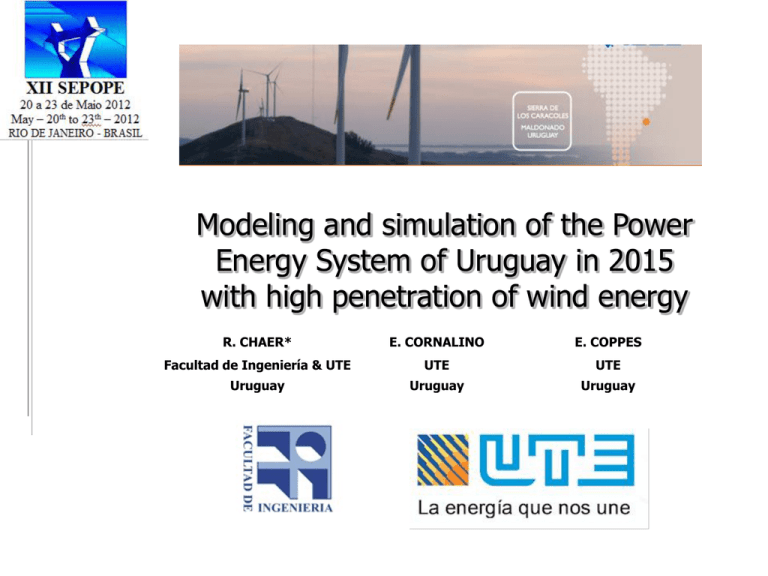Modeling and simulation of the Power Energy System of Uruguay in
advertisement

Modeling and simulation of the Power Energy System of Uruguay in 2015 with high penetration of wind energy R. CHAER* E. CORNALINO E. COPPES Facultad de Ingeniería & UTE UTE UTE Uruguay Uruguay Uruguay SUMMARY This paper presents the results of detailed simulations of the operation of the power system of Uruguay, for the year 2015 when it reached the target of 1200 MW of wind power in the system. This level of win integration will be near the 60% of de peak of demand. The results show that this level of integration is manageable thanks to the large installed hydro power capacity in the country. A picture of 2015 Capacity vs. Peak •The ceil-goal for 2015 is to reach 1200 MW of installed wind power capacity. 60% •The Expected demand for 2015 is about 1500 MW on average, with a peak of 2000 MW. •Wind penetration then will be of 60% in capacity and 33% in energy Energy 33% •How the system will be operated in 2015 with this such high share of wind power? •Are the available resources enough to compensate the wind power variations? Uruguay – 2015 (expected generation by source) Wind Stochastic Model - CEGH A stochastic model with Gaussian Space Correlations with Histogram was identified using hourly series of wind measures obtained in 7 sites distributed over the country during 2 year . The model represents the temporal and geographical correlation between sites and patterns the wind direction for site. Also represents the annual and daily seasonality the resource Details This stochastic model was used to perform a simulation of operation of the system in 2015 using an integration time-step of one hour with the simulator SimSEE. All power plants in Uruguay are represented in this simulation, including: hydroelectric plants with their storage capacity and gas-oil, fuel-oil, bio-fuel and natural gas fired thermal units. Two major questions Is the model used for long-term planning valid for dealing with high wind energy integration? Does the energy system of Uruguay has enought resources to handle the time variability of wind? Modelling for Long Term Planning The model used for the optimal planning of investments in generation uses a weekly time step divided into four time bands. (patamares) This model is executed hundreds of thousands of times for determining the optimal investment plan. Due to weekly integration step the model is not able to adequately represent the effect of time variations of the wind farms output over the rest of the generating units. Modelling Long term vs. Short term Investment Planning - Long term Time Step: weekly dividen in 4 hourly-bands (PATAMARES) Hydros with reservoires: Bonete Wind Farms Output: stochastic, averaged by hourly-band Operation Planning - Short term Time Step: hourly Hydros with reservoires: Bonete, Palmar and Salto Grande Wind Farms Output: stochastic, averaged by hourly-band Wind Energy (Weekly – Hourly) There is no significant differences since the weakly model of wind farms production was calibrated averaging the hourly model. Hydroelectric (Weekly – Hourly) Could be in the order of 582 GWh per year of energy surplus available from the hydro-subsystem in the actual operation of the system. This surplus is achieved by the effect of better management of the lakes with short-term storage capacity. Exports (Weekly – Hourly) Could be in the order of 50 GWh per year of energy surplus available for export in the actual operation of the system. This surplus is achieved by the effect of better management of the lakes with short-term storage capacity. Exportable surplus = Overcost • For expansion planning it was assumed that the system purchases all the energy generated by wind farms at 65 USD/MWh; and that all the energy surplus are exported at 10 USD/MWh to neighboring countries. • So a 50 GWh/year of exportable surplus respresents a overcost of 50000 x (65-10) = 2 MUSD/year. • This represent an increase in the price of wind energy of 0.75 USD/MWh. Prices used for the long term planning. The estimates of the optimal amount of wind power to be installed in the system were performed initially priced at 90 USD/MWh and subsequently with 70 and 65 USD/MWh obtaining the same results in terms of the amount of power to be installed within the margin of error of the used tools. Therefore this change in price due to surpluses recorded in the hourly simulation over the weekly one, does not change the conclusions regarding the optimal amount of wind power to be installed in the system. First conclusion As shown, the economic impact of the difference between both runs, changes the price of wind power less than the price variations that were considered in the study of sensitivity. Then, we consider validated the model used for planning respect to the result of install 1200 MW in the next years. But in the future to continue adding wind farms to the system, the weekly time step must be shorten to represent adecuality the filtering efect of the small lakes. For filtering the wind energy variation they are not small. Does the energy system of Uruguay has enought resources to handle the time variability of wind energy? What are the variations? • • • • • • • 1 second 1 minute 1 hour 1 day 1 weak 1 month 1 year Turbine-Machine intertial filter Geographical filter inter-farms Forecasting Extra load following resources Traditional operation resources Salto Grande (50% UY) 945MW 8 days Palmar 333MW 22 days Baygorria 108MW 3 days Hydroelectric Plants 1541 MW Bonete 155MW 140 days Fast fuel fired units 6 x 50 MW = 300 MW GT Punta del Tigre 8 x 10 MW = 80 MW Engines 2 x 100 MW = 200 MW GT La Tablada 540 MW CC (in bidding proccess) Interconnections • 2000 MW With Argentina • 570 MW with Brasil • For planning purposes the import is considered closed. 01/03/2015 01/03/2015 03:00 01/03/2015 06:00 01/03/2015 09:00 01/03/2015 12:00 01/03/2015 15:00 01/03/2015 18:00 01/03/2015 21:00 02/03/2015 02/03/2015 03:00 02/03/2015 06:00 02/03/2015 09:00 02/03/2015 12:00 02/03/2015 15:00 02/03/2015 18:00 02/03/2015 21:00 03/03/2015 03/03/2015 03:00 03/03/2015 06:00 03/03/2015 09:00 03/03/2015 12:00 03/03/2015 15:00 03/03/2015 18:00 03/03/2015 21:00 04/03/2015 04/03/2015 03:00 04/03/2015 06:00 04/03/2015 09:00 04/03/2015 12:00 04/03/2015 15:00 04/03/2015 18:00 04/03/2015 21:00 05/03/2015 05/03/2015 03:00 05/03/2015 06:00 05/03/2015 09:00 05/03/2015 12:00 05/03/2015 15:00 05/03/2015 18:00 05/03/2015 21:00 06/03/2015 06/03/2015 03:00 06/03/2015 06:00 06/03/2015 09:00 06/03/2015 12:00 06/03/2015 15:00 06/03/2015 18:00 06/03/2015 21:00 MW A week of 2015 Demanda y generación eólica - 1° semana de Marzo - posibles realizaciones 1800 1600 Demanda EOL_1 EOL_2 EOL_3 1400 1200 1000 800 600 400 200 0 01/03/2015 01/03/2015 03:00 01/03/2015 06:00 01/03/2015 09:00 01/03/2015 12:00 01/03/2015 15:00 01/03/2015 18:00 01/03/2015 21:00 02/03/2015 02/03/2015 03:00 02/03/2015 06:00 02/03/2015 09:00 02/03/2015 12:00 02/03/2015 15:00 02/03/2015 18:00 02/03/2015 21:00 03/03/2015 03/03/2015 03:00 03/03/2015 06:00 03/03/2015 09:00 03/03/2015 12:00 03/03/2015 15:00 03/03/2015 18:00 03/03/2015 21:00 04/03/2015 04/03/2015 03:00 04/03/2015 06:00 04/03/2015 09:00 04/03/2015 12:00 04/03/2015 15:00 04/03/2015 18:00 04/03/2015 21:00 05/03/2015 05/03/2015 03:00 05/03/2015 06:00 05/03/2015 09:00 05/03/2015 12:00 05/03/2015 15:00 05/03/2015 18:00 05/03/2015 21:00 06/03/2015 06/03/2015 03:00 06/03/2015 06:00 06/03/2015 09:00 06/03/2015 12:00 06/03/2015 15:00 06/03/2015 18:00 06/03/2015 21:00 MW Net Demand 1600 Demanda neta - 1° semana de marzo - posibles realizaciones Demanda Neta_1 Demanda Neta_2 Demanda Neta_3 1400 1200 1000 800 600 400 200 0 January 2015 hydrology assuming historical low January 2015 assuming very high hydrology Hourly Simulations 2015 • considering two scenarios, one with 1200 MW wind power installed capacity and one without wind power. • Results were analyzed from the point of view of increasing variability of power generation, induced by wind generation. To do this we compared the variations in power from one hour to the following for energy sources with possibilities of fast regulation: hydraulics, gas turbines and engines. • We do that by comparing the cumulative probability plots of the time differences of power, P(h) - P(h-1), of the simulated cases with wind and without wind. Fast-Thermal units variations Cumulative probability of hourly changes of thermal power 600 simulation with wind dP_term 400 simulation with wind dP_term dP térmicas (MW) 200 000 0% -200 -400 -600 10% 20% 30% 40% 50% 60% 70% 80% 90% 100% Hydro power Cumulative probability of hourly changes of hydro power 800 600 simulation with wind simulation with wind 400 historic (S. G. Regulating) historic (S. G. NO Regulating) dP Hid (MW) 200 000 0% -200 -400 -600 -800 10% 20% 30% 40% 50% 60% 70% 80% 90% 100% Hydro subsystem Cumulative probability of hourly changes of hydro power 800 600 simulation with wind simulation with wind 400 historic (S. G. Regulating) historic (S. G. NO Regulating) dP Hid (MW) 200 000 0% -200 -400 -600 -800 10% 20% 30% 40% 50% 60% 70% 80% 90% 100% It notes that the expected time variations of the hydraulic power to the system without wind power are the same level as the historical variations of the periods in which Salto Grande is not carrying out secondary regulation, while the expected variations for the system with 1200 MW of wind are similar to the historical variations in when Salto Grande is carrying secondary regulation. Exports Cumulative probability of hourly changes of exported power 600 simulation with wind dP_expo 400 simulation with wind dP_expo dP exportación (MW) 200 000 0% -200 -400 -600 10% 20% 30% 40% 50% 60% 70% 80% 90% 100% Exports As can be seen in 80% of time is not necessary to use exporting power to regulate the system. It is remarkable that to meet the requirements in the remaining 20% of the time Uruguay has the ability to export to Argentina through the existing interconnection of 2000 MW and to Brazil through the interconnection of 70 MW already in operation plus 500 MW currently under construction. If the interconnections are not able to handle these increases of 200 MW the solution should be to reduce the power generated in the wind farms in those situations. Second Conclusion • The system should be capable to handle the variability of the 1200 MW in 2015. • If the 2570 MW interconnection with Brazil and Argentina can not be used to absorb variations of 200 MW in less than 20% of the time, you should use to reduce the power generated by wind farms in those circumstances. That all folks.









